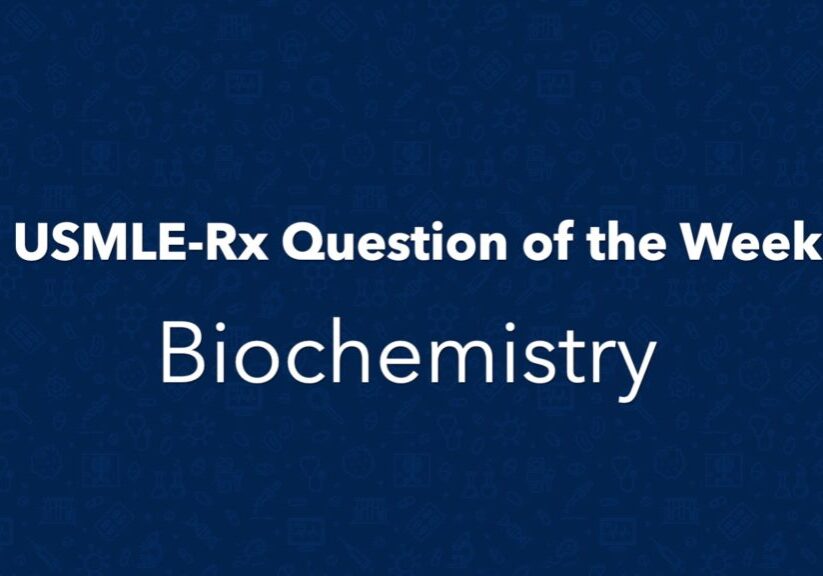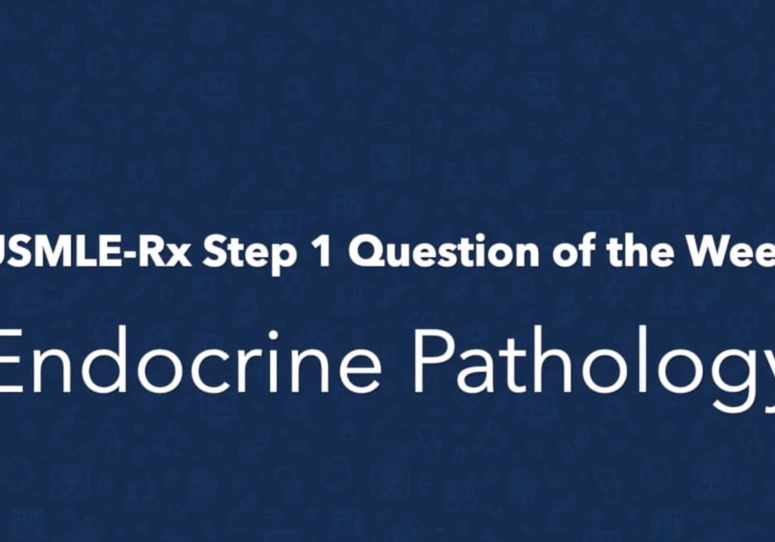Check out today’s Step 1 Qmax Question Challenge.
Know the answer? Post it below! Don’t forget to check back for an update with the correct answer and explanation (we’ll post it in the comments section below).
 A 65-year-old woman presents to her physician with the new onset of a severe headache and malaise. The headache is constant, unilateral, and located in the frontotemporal region. The pain is not aggravated by light neck flexion. She has not experienced nausea, vomiting, or a rash, and there is no history of head trauma or headache syndromes, but she has noted a 10-lb (4.5-kg) weight loss in the past 3 weeks. On physical examination, her temperature is 38.1°C (100.6°F), blood pressure is 120/70 mm Hg, and heart rate is 90/min. MRI of the brain shows no abnormality. A biopsy is performed over the area of pain. Some of the vessels in the biopsy specimen, shown in the image, show granulomatous inflammation with plentiful multinucleated giant cells.
A 65-year-old woman presents to her physician with the new onset of a severe headache and malaise. The headache is constant, unilateral, and located in the frontotemporal region. The pain is not aggravated by light neck flexion. She has not experienced nausea, vomiting, or a rash, and there is no history of head trauma or headache syndromes, but she has noted a 10-lb (4.5-kg) weight loss in the past 3 weeks. On physical examination, her temperature is 38.1°C (100.6°F), blood pressure is 120/70 mm Hg, and heart rate is 90/min. MRI of the brain shows no abnormality. A biopsy is performed over the area of pain. Some of the vessels in the biopsy specimen, shown in the image, show granulomatous inflammation with plentiful multinucleated giant cells.
What agent is most likely to be an effective treatment for this patient’s condition?
A. Aspirin and intravenous immune globulin
B. Azathioprine
C. Doxycycline
D. Prednisone
E. Sumatriptan
———————–
Want to know the ‘bottom line?’ Purchase a USMLE-Rx Subscription and get many more features, more questions, and passages from First Aid, including images, references, and other facts relevant to this question.
This practice question is an actual question from the USMLE-Rx Step 1 test bank. For more USMLE Step 1 prep, subscribe to our Flash Facts and Step 1 Express video series. Score the best deal on all three products with a Step 1 Triple Play Bundle.




D.
Obviously D. Classic Temporal Arteritis.
D
D. Should be used asap. to preserve vision.
temporal arteritis needs Prednisolone . the answer is D
The correct answer is D. The patient’s symptoms (low-grade fever, weight loss, headache) and the biopsy findings indicate that she has giant cell (temporal) arteritis, the most common form of vasculitis. Hematoxylin-eosin-stained preparation, as shown in the image, demonstrates degeneration of the internal elastic lamina. The temporal artery is most commonly affected, followed by other branches of the carotid artery (vertebral and ophthalmic arteries). Corticosteroids are quite effective for managing temporal arteritis and must be administered quickly to prevent the serious complication of blindness. In the United States, approximately 15% of patients with temporal arteritis also have polymyalgia rheumatica.
A is not correct. Kawasaki disease is treated with intravenous immune globulin and aspirin. It is a vasculitis of medium-sized arteries that typically occurs in pediatric patients, with findings of elevated erythrocyte sedimentation rate and C-reactive protein, high fever, strawberry tongue, lymphadenopathy, bright-red cracked lips, conjunctivitis, and swollen hands and feet. Another name for Kawasaki disease is mucocutaneous node disease.
B is not correct. Azathioprine is a disease-modifying antirheumatic drug. Someone with rheumatoid arthritis would not present with this patient’s symptoms. Rheumatoid arthritis is an autoimmune disorder that manifests with joint destruction. Headaches are not typical of rheumatoid arthritis.
C is not correct. Doxycycline is used to treat Rocky Mountain spotted fever. This infection often does present with headache, but this would be accompanied by high fever, rash not sparing the palms and soles, and constitutional symptoms.
E is not correct. Serotonin agonists are sometimes used to treat migraines, but this patient’s clinical picture does not fit with migraine. Migraine headache is often one-sided, exacerbated by activity and bright lights, and accompanied by nausea and vomiting.
I am really impressed with your writing skills and also with the layout on your blog. Is this a paid theme or did you modify it yourself? Anyway keep up the excellent quality writing, it? rare to see a great blog like this one today..